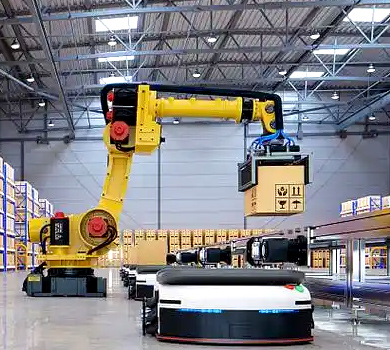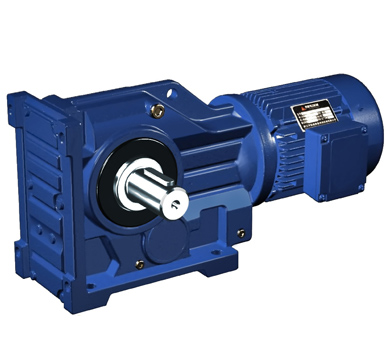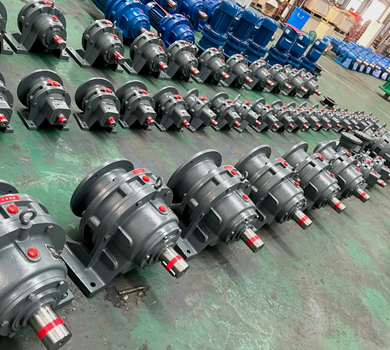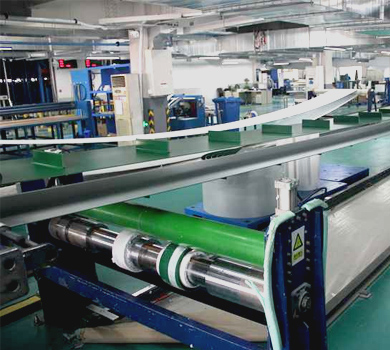In the context of deep integration between intelligent manufacturing and global supply chains, heavy-duty conveyor belt buffer feeding systems - as the core hub of logistics automation - are undergoing threefold technological transformations: ultra-large scale (single-line capacity ≥80 tons), ultra-high speed (≥4m/s), and ultra-intelligence. This article analyzes a production line upgrade case of a multinational construction machinery enterprise to demonstrate how waimica reconstructs the value system of heavy-duty logistics transmission systems through technological innovation.
1. Industry Challenges and Pain Points Analysis
Modern heavy-duty logistics systems exhibit three major technical characteristics:
- Aggravated compound operating conditions: Must simultaneously handle high-frequency start-stop (≥120 times/hour), eccentric load impacts (dynamic load coefficient 1.8-2.2), and continuous forward-reverse operations
- Energy efficiency structure conflicts: Traditional reducers sacrifice 30% heat dissipation performance to meet IP67 protection, leading to oil temperature exceeding limits (>90℃) during continuous operation
- Uncontrolled maintenance costs: Heavy-duty gearboxes require lubricating oil replacement every 1,500 hours on average, with lifecycle maintenance costs accounting for 35% of equipment procurement price
Typical equipment consists of a servo motor, reducer, ball screw, buffer spring assembly, and position sensor forming a power closed-loop. The industry currently faces four technical bottlenecks:
- Dynamic response lag in transmission systems causing excessive material impact (>200mm/s²)
- Gearbox volume/weight restricting modular equipment design (traditional solutions have volume density <150N·m/L)
- Sealing systems averaging only 800-hour failure cycles under dusty conditions
- Non-standard selection increasing spare parts inventory costs by 40%
2. Evolution of Reducer Technical Requirements
As the "nerve center" of power transmission, modern heavy-duty logistics systems impose seven core requirements on reducers:
| Performance Dimension | Technical Indicators |
|---|---|
| Torque density | ≥200N·m/kg (achieving >40% drive unit weight reduction) |
| Transmission accuracy | Rotational backlash ≤0.5 arcmin, repeat positioning accuracy ±0.005mm |
| Dynamic characteristics | Torque establishment time <30ms, adaptable to ±50% load mutations |
| Environmental adaptability | -40℃~70℃ wide temperature operation, ISO 9227 standard salt spray corrosion resistance |
| Service life | L10 life ≥80,000 hours (per ISO 6336-2 calculation) |
| Maintenance-free design | Grease replacement cycle ≥5 years, seal life ≥30,000 hours |
| Compatibility | Supports IEC, NEMA, and JIS standard flange interfaces |
3. waimica Innovative Solution Matrix
Structural Design Breakthroughs
- Asymmetric tooth profile modification technology: Optimizes tooth contact lines via KISSsoft software, reducing contact stress by 37%
- Sandwich modular architecture: Three-segment input/output/body design supporting flange/shaft/torque arm mounting
- Double-helix cooling channels: 360° annular fins + built-in heat pipes on φ200mm body, measured continuous operation temperature rise ≤50℃
Performance Parameter Comparison
| Parameter | waimica BSR-300 | Nabtesco RF Series | Harmonic Drive CSF Series |
|---|---|---|---|
| Rated torque (N·m) | 3000 | 2500 | 2800 |
| Radial dimension (mm) | 280 | 310 | 295 |
| Transmission efficiency (%) | 95.2 | 93.5 | 90.1 |
| Protection grade | IP69K | IP67 | IP66 |
| Backlash (arcmin) | ≤0.3 | ≤0.8 | ≤2 |
Special Condition Adaptations
- Food-grade lubrication solution: FDA 21 CFR 178.3570 certified, meeting cleanroom ISO Class 1 requirements
- Explosion-proof option package: ATEX Zone 2/22 certification, surface temperature ≤135℃
- Vibration suppression technology: Built-in dynamic balancing rings elevating system resonance frequency above 300Hz
4. Typical Application Case Study
Project Background
A leading global construction machinery manufacturer's excavator structural component conveyor line in India faced these issues with a European brand reducer:
- Lead screw bending deformation during heavy-duty startup (reaching 0.45mm)
- Quarterly 72-hour gearbox maintenance downtime
- Annual maintenance costs reaching 28% of equipment procurement price
waimica Solution Implementation
- 3D simulation verification: Gear mesh stiffness analysis via Romax Designer optimized tooth profile modification curves
- Dynamic characteristic matching: Constructed mechatronic-hydraulic coupling model in AMESim, elevating system damping ratio from 0.15 to 0.42
- Field commissioning support: Deployed Sino-German joint technical team completing full process from installation to parameter tuning within 48 hours
Implementation Results
| Metric | Before | After | Improvement Rate |
|---|---|---|---|
| MTBF (hours) | 3200 | 6800 | +112.5% |
| Energy efficiency (kW·h/ton) | 0.48 | 0.34 | -29.2% |
| Maintenance hours/year | 864 | 96 | -88.9% |
5. Technological Value and Industry Outlook
waimica has established unique competitive advantages through three technological pillars: materials science breakthroughs (high-purity carburized steel heat treatment), manufacturing precision leap (gear grinding accuracy reaching ISO 1328-1:2013 Grade 2), and intelligent operation integration (built-in temperature/vibration sensors for predictive maintenance). We not only achieve 95% performance parity with international brands but also redefine the value equation of premium reducers through 35% cost advantage, 5-week standard delivery cycle, and 24/7 global service network.
Facing the evolution trend of logistics automation toward ultra-high speed (>6m/s), ultra-heavy load (>150 tons), and ultra-clean (ISO Class 0) directions, waimica will continue investing in ceramic bearings, magnetic levitation transmission, digital twin debugging, and other frontier technologies to become the "hidden champion" in global intelligent manufacturing transmission. Our technology roadmap shows by 2027, we will achieve:
- Torque density breakthrough of 250N·m/kg
- Transmission efficiency提升至97%
- Predictive maintenance accuracy ≥90%









